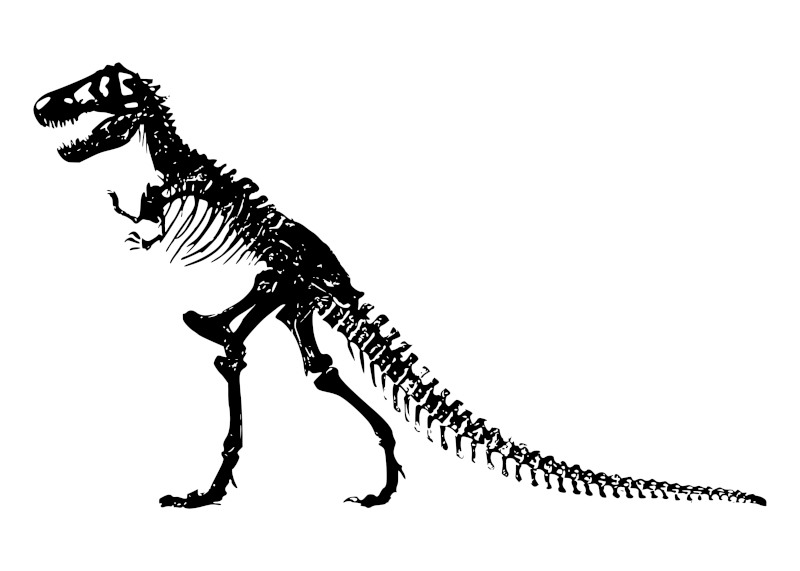This article brings together some fun but simple dinosaur drawings from the realms of art history for you to enjoy. Amateur artists of all levels, including beginners, can learn how to draw dinosaurs by browsing these examples.
Introduction to Dinosaur Drawings
Dinosaurs have excited us all for centuries but have only been known about for a relatively short period. As such, their involvement in art cannot be traced that far back, although many of their descendants have lasted longer. Today dinosaurs are most present in children's art, with youngsters regularly being excited about these creatures, leading to them appearing in cartoons and children's literature as fun illustrations.
In a similar manner to a number of other creatures such as frogs, cats and dogs, artists have started to append human expressions and features to dinosaurs in order to make them more palatable to their younger audience, and this is a common techniques that runs through film, television and mainstream literature. You will see many examples of this in action below, with our extensive list of dinosaur depictions, covering drawings and paintings in a variety of styles covering the past few centuries.
List of Dinosaur Drawings and Paintings
We have sourced a number of images from Rawpixel which have been provided as copyright-free, covering different dinosaur images that you might use as inspiration for your own work. Beginners might be wise to trace some of the simpler works below to produce dinosaur line drawings, which you can then fill in with color or more detail at your own leisure. Further below, we have also included more information and discussion around a number of themes related to dinosaur art, including the most popular species.
Besides each image, there is also information on the artist themself, where they are known. We have aimed to provide as wide ranging a list of drawings as possible, in order to provide you with a mixture of inspiration, and hope that this collection is helpful. Further creatures are listed in our drawings section, which continues to grow with new ideas for your work, and it remains a great place to start making quick, easy drawings as a beginner or intermediate.
Dinosaur Skeleton in Side Profile Illustration
This image of a dinosaur skeleton to how most of us will experience these wonderful creatures today, when visiting museums around the world. This illustration helps us to see each and every part of the anatomy, at least from the bone structure, and its nature as a black and white artwork helps each detail to stand out clearly. One might trace the outline of this image in order to quickly put together an easy dinosaur drawing, but those looking to add color accurately would need to consult other artworks and publications. The side profile is also a popular choice as it reveals so much about the dinosaur from this angle.
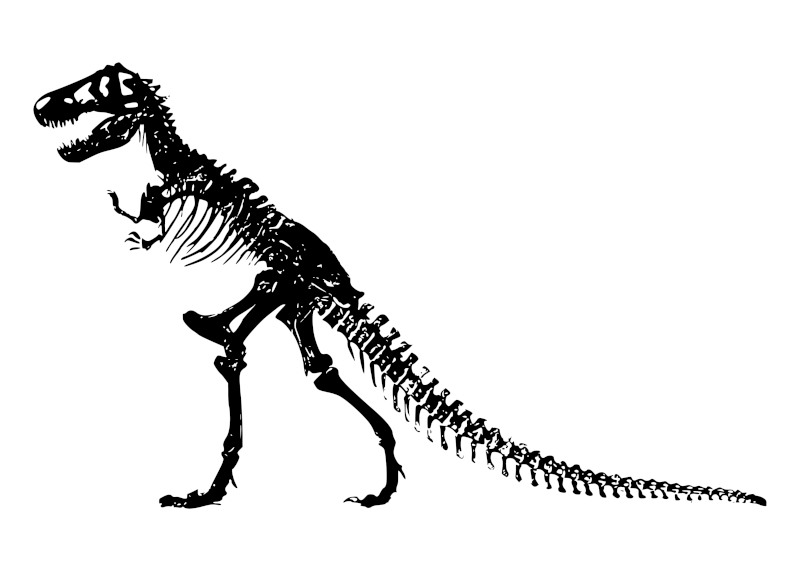 Dinosaur Skeleton in Side Profile Illustration (image courtesy of rawpixel, provided by them as copyright-free)
Dinosaur Skeleton in Side Profile Illustration (image courtesy of rawpixel, provided by them as copyright-free)
Vintage Dinosaur Drawing of Long-Necked Creature
This illustration aims to portray a living dinosaur and replicate its postures all those years ago. There is sufficient detail to understand many elements of this dinosaur, but it could still have been completed relatively quickly. This particular dinosaur is long in its anatomy, and the artist skillfully curls the tail around in order to keep the image central, and avoid having to widen the composition. It is likely that the artist would have had to work from a variety of sources in order to complete this work, with no live options available.
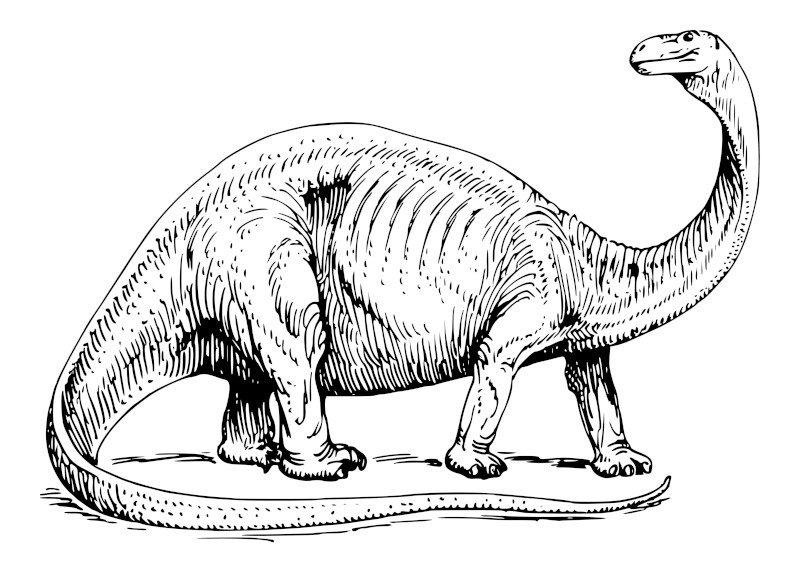 Vintage Dinosaur Drawing of Long-Necked Creature (image courtesy of rawpixel, provided by them as copyright-free)
Vintage Dinosaur Drawing of Long-Necked Creature (image courtesy of rawpixel, provided by them as copyright-free)
Flying Dinosaur Quick Easy Sketch
Here we find one of the famous flying dinosaurs which changed our understanding of the species as a whole. For many years, it was not believed that any dinosaurs could fly, but several new discoveries corrected this view. This illustration shows the dinosaur with its wings stretched out wide, as it patrols the skies. Many will see a resemblance to modern day bats, in the structure of the wings, and the placement of the main torso within it. These may not be considered beautiful creatures, but their abilities make them one of the most discussed elements of the dinosaur era.
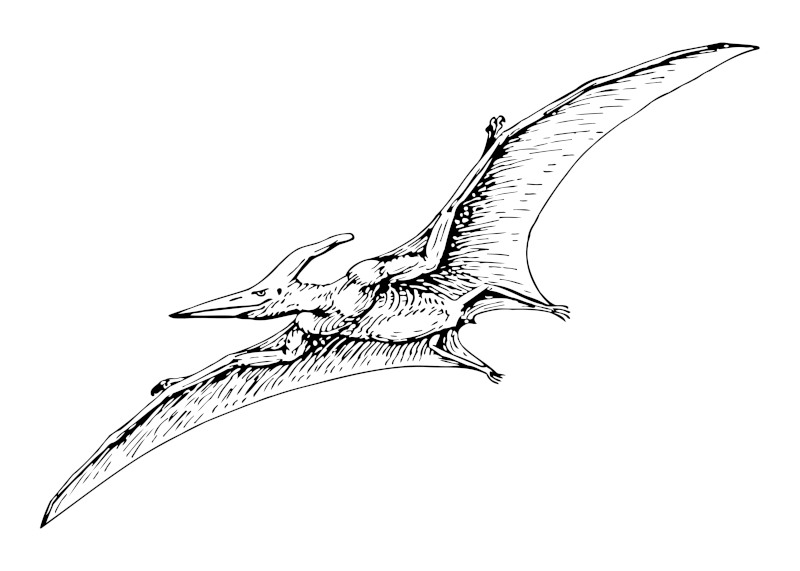 Flying Dinosaur Quick Easy Sketch (image courtesy of rawpixel, provided by them as copyright-free)
Flying Dinosaur Quick Easy Sketch (image courtesy of rawpixel, provided by them as copyright-free)
Stegosaurus Hand Drawn Line Drawing
The Stegosaurus is amongst the most recognisable dinosaurs thanks to its iconic bony plates which jut out from its back and run along its tail. Here an artist captures its beauty in a relaxed manner in which perspective is somewhat distorted, with its face looking unusually small in comparison to the rest of its body. One could still use this image as a basis for sketching out a Stegosaurus of their own, but it is always best for beginners to keep it simple at the start, before increasing in complexity over time.
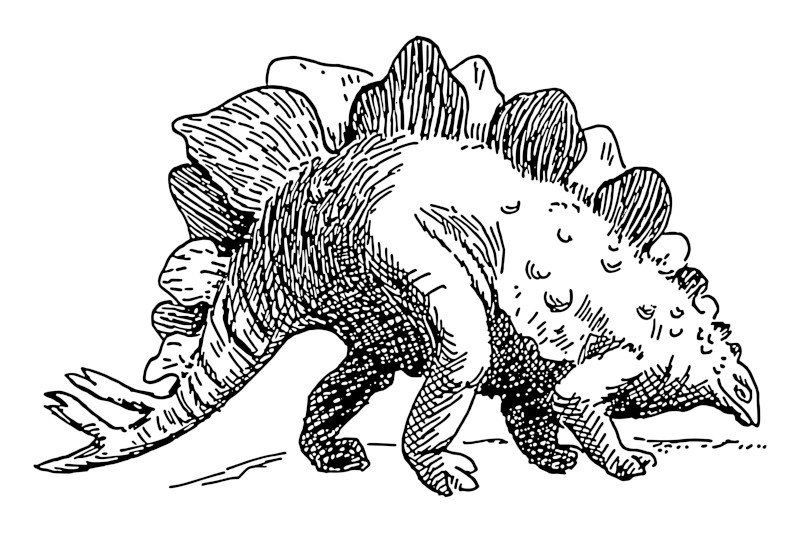 Stegosaurus Hand Drawn Line Drawing (image courtesy of rawpixel, provided by them as copyright-free)
Stegosaurus Hand Drawn Line Drawing (image courtesy of rawpixel, provided by them as copyright-free)
Walking Dinosaur Black and White Illustration
This illustration captures a dinosaur walking, with the artist taking an angle of behind and to the side. Heavy shadowing is used beneath the dinosaur's body, partcularly around its torso, in order to increase the sense of volume and perspective, whilst this angle also accentuates the length of this creature, as we run our eyes directly from the tip of its tail all the way up to its head. Its head is particularly small by comparison to the rest of its body, but this is not inaccurate to this particular dinosaur.
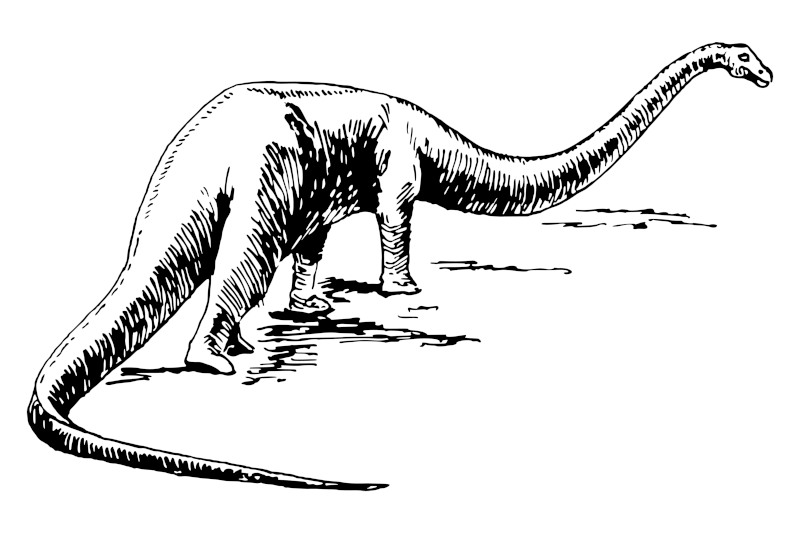 Walking Dinosaur Black and White Illustration (image courtesy of rawpixel, provided by them as copyright-free)
Walking Dinosaur Black and White Illustration (image courtesy of rawpixel, provided by them as copyright-free)
Children's Cartoon Tyrannosaurus
Here we can enjoy a fun cartoon image of a Tyrannosaurus Rex, a dinosaur that probably remains the best known of all those that we have discovered so far. It is recognisable for its height and aggression, whilst having small arms which have evolved for its specific needs. Clearly this cartoon-like interpretation is not intended to be anatomically accurate and is softened in appearance in order to make it more palatable to a young audience. For this reason, it is colored in bright tones and this type of image could easily be transitioned across into children's literature, fashion or film and television.
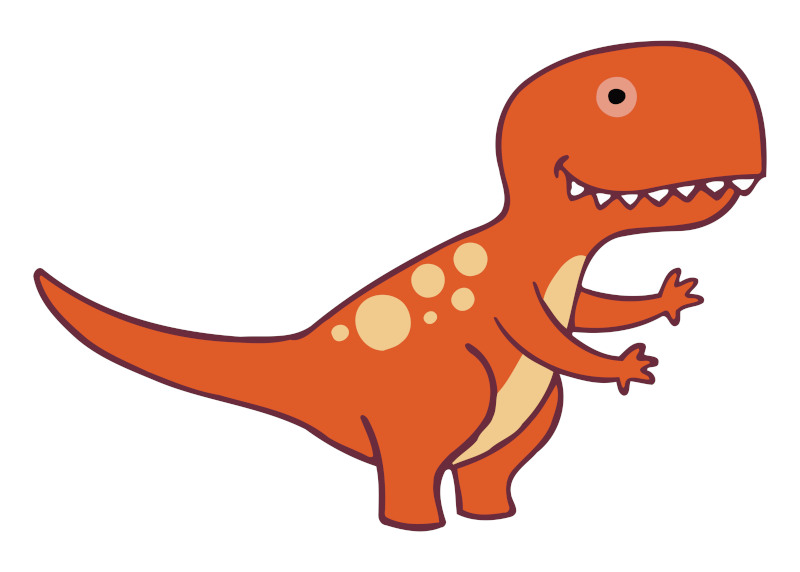 Children's Cartoon Tyrannosaurus (image courtesy of rawpixel, provided by them as copyright-free)
Children's Cartoon Tyrannosaurus (image courtesy of rawpixel, provided by them as copyright-free)
Stegosaurus Dinosaur Colored Drawing
Here we find a further fun, quick and easy interpretation of a dinosaur with a liberal use of artistic expression in order to produce something attractive to younger audiences. There would be no reason to scare children with the reality of dinosaurs, and something more suitable such as this can help to gain their interest in dinosaurs more generally. Some will then learn about the concepts of extinction, and apply it to modern ideas around conservation, so that other species can be protected for the future.
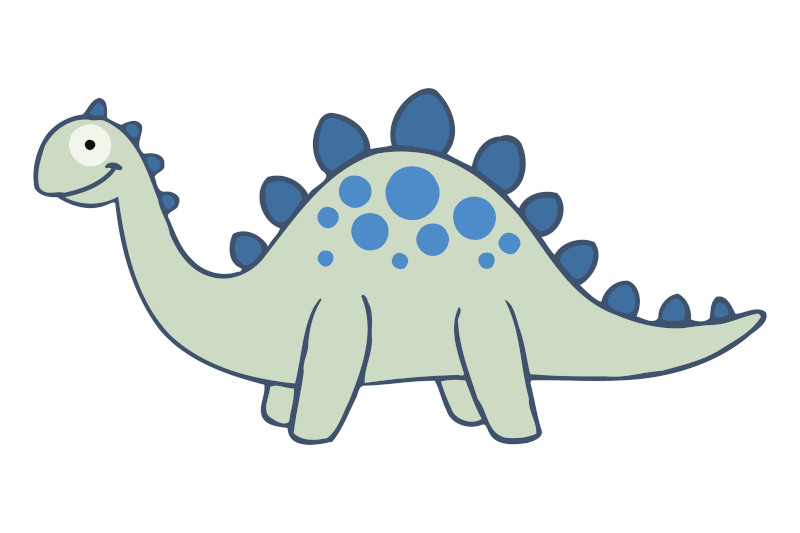 Stegosaurus Dinosaur Colored Drawing (image courtesy of rawpixel, provided by them as copyright-free)
Stegosaurus Dinosaur Colored Drawing (image courtesy of rawpixel, provided by them as copyright-free)
Quick Easy Brontosaurus Dinosaur Sketch with Color
This sketch in color is likely to be of a Brontosaurus, albeit within a cartoon-like style. Artists have made dinosaur drawings in all manner of different ways over the years, and this artwork is typical of the late 20th century approach, in which dinosaurs are essentially re-branded into cuddly creatures, as also seen in a number of cartoons, fashion and illustrations across children's story books.
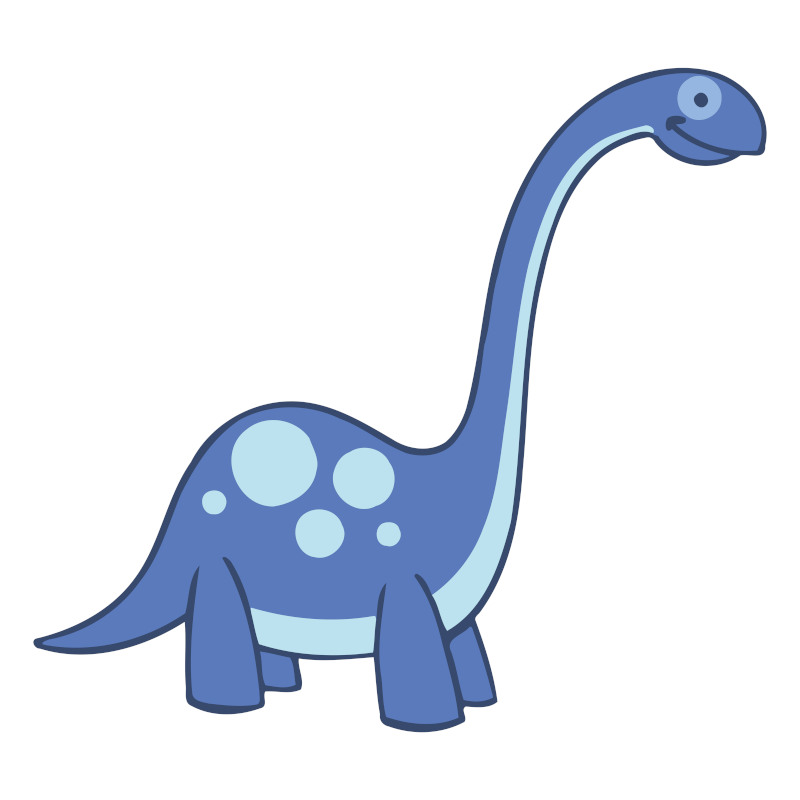 Quick Easy Brontosaurus Dinosaur Sketch with Color (image courtesy of rawpixel, provided by them as copyright-free)
Quick Easy Brontosaurus Dinosaur Sketch with Color (image courtesy of rawpixel, provided by them as copyright-free)
Triceratops Dinosaur
The Triceratops is another highly recognisable dinosaur which can find displayed here. Its sharp horns are particularly well known aspects of its anatomy, and the strong bones which protect its head are also aesthetically interesting and tell us much about how it lived its own life. This work is kept simple, with relatively little detail or variety of color, yet still we can instantly recognise it as a Triceratops.
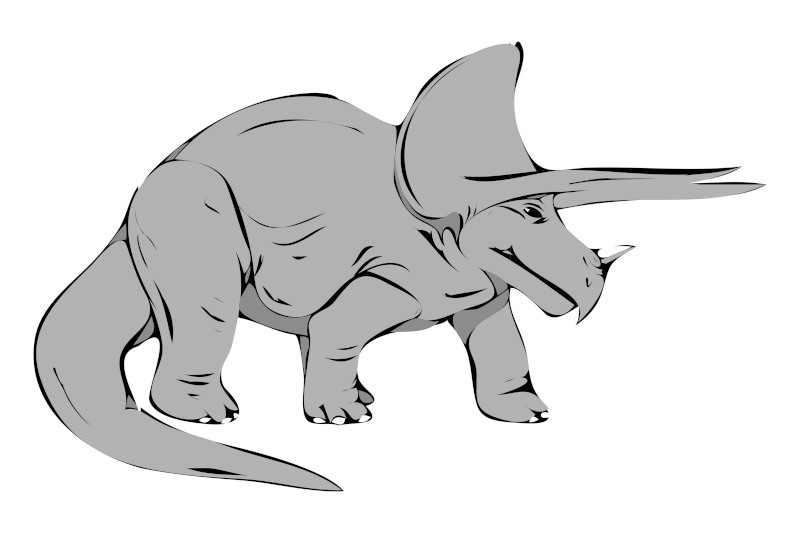 Triceratops Dinosaur (image courtesy of rawpixel, provided by them as copyright-free)
Triceratops Dinosaur (image courtesy of rawpixel, provided by them as copyright-free)
Detailed Coelophysis Painting
The Jurassic Park series of films drew attention to a number of lesser known species of dinosaurs, including some smaller, faster types such as the Coelophysis. Here we find a simple painting of one, with a small use of color but also some attention to the striped detail running across its body. Much can be learnt about a dinosaur from its anatomy, such as how it caught its prey, what it ate, and also the types of dinosaurs that could be the most dangerous towards its survival.
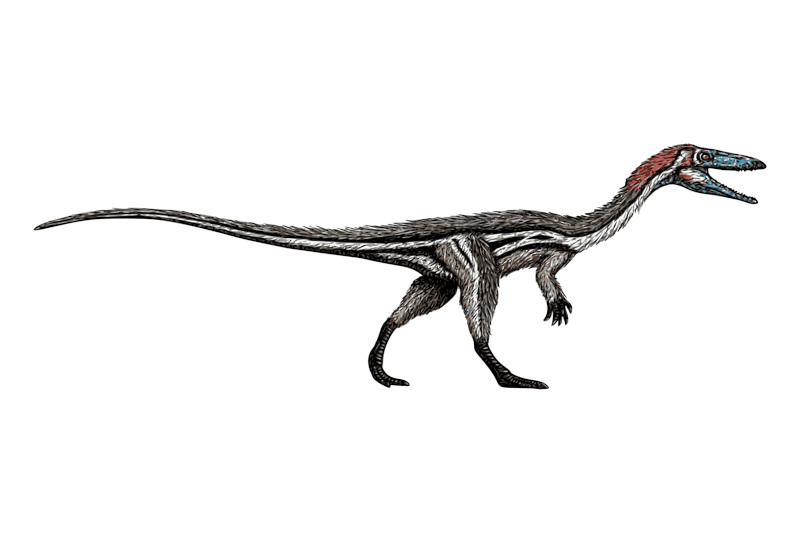 Detailed Coelophysis Painting (image courtesy of rawpixel, provided by them as copyright-free)
Detailed Coelophysis Painting (image courtesy of rawpixel, provided by them as copyright-free)
Line Drawing of Standing Dinosaur
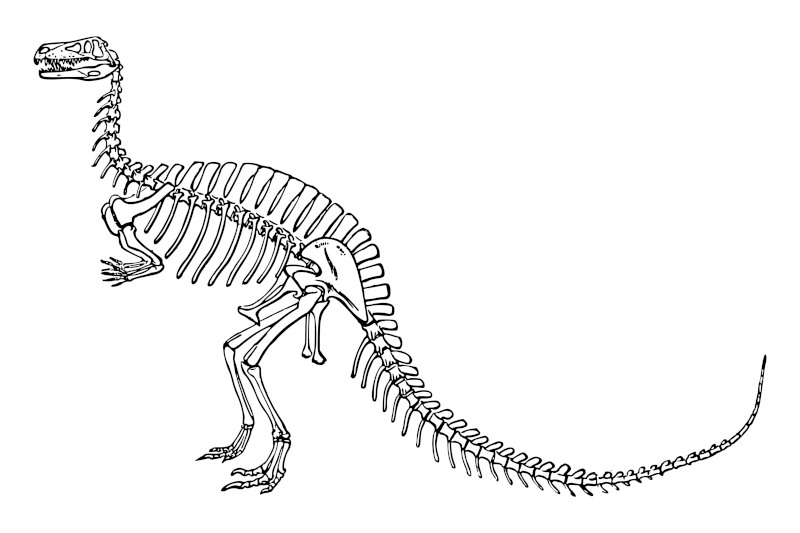 Line Drawing of Standing Dinosaur (image courtesy of rawpixel, provided by them as copyright-free)
Line Drawing of Standing Dinosaur (image courtesy of rawpixel, provided by them as copyright-free)
Dinosaur drawing, extinct animal vintage illustration
 Dinosaur drawing, extinct animal vintage illustration (image courtesy of rawpixel, provided by them as copyright-free)
Dinosaur drawing, extinct animal vintage illustration (image courtesy of rawpixel, provided by them as copyright-free)
19th Century Dinosaur Discoveries and Artistic Interpretations
The 19th century was a crucial period in the evolution of our understanding of dinosaurs, with several crucial discoveries and publications helping to spread our knowlege quickly across the western world. The spread of western powers at this time also allowed discoveries to occur all across the world, with scientists and historians afforded new territories with which to research the past. There would be a significant change in societies after the discovery of dinosaurs, with it helping to re-focus our view of the past, which had previously been dominated by religious scripture.
As new discoveries came about, experts would start to evolve our knowledge into the behavior of dinosaurs, as much can be learnt from their evolution over thousands of years, where different anatomical attributes start to emerge. Dinosaur art would match this evolving knowledge, attempting to visually replicate over time what we knew about these exciting creatures. Notable discoveries in the likes of the UK, US and mainland Europe would shake our understanding every now and again, leading to frontpage news in a newspaper-dominated era.
Just as had occurred with plants and flowers, artists would work alongside experts in their fields to illustrate and document new discoveries and accurately depict how they would have appeared at the time. For dinosaurs, there were many questions to answer, besides just how they looked - at which era might they have existed, and how would they have lived at that time alongside other species.
Impact of New Fossil Finds on Artistic Representation
Fossils have been crucial in quickly expanding our knowledge of dinosaurs. Rather than waiting for the occasional large-scale bone finds, we have been able to evolve our understanding at a steady pace thanks to the abundance of dinosaur fossils which are far more plentiful and also regularly exposed to the surface. Some regions across the world have built up reputations for their steady streams, and some of these were crucial in our discovery of featured dinosaurs for the first time.
Many of the fossils have helped to fill in the blanks of our knowledge around the skeletons found elsewhere, and additionally they have been of tremendous value in making dinosaur discovery much to accessible to all - those willing to spend a little time in any of these fossil hotspots will soon have remnants from that time within their own hands, and the abundance of what is available means most can be kept to ourselves. Artists have chosen to sketch fossils themselves, as well as the creatures that they give an indication of.
Artists Who Shaped the Genre
Charles R. Knight (1874–1953) is considered by many to have been the pioneer of paleo art. As with many other 19th century artists, he combined art with science to roll out whole series of illustrations which were aesthetically impressive whilst also helping to educate the masses on these various species. His work was also picked up by museums who used his dinosaur art to embellish their displays and work alongside existing, related collections of bones and fossils.
Zdeněk Burian was a more recent dinosaur artist who went even further in terms of detail in his work and can be described as the next wave of artists who took this genre onwards. There remain new arrivals all the time, though modern dinosaur artists tend to focus on fun and entertainment, creating animations and children's literature, though the genre has widened to allow all manner of other ideas to co-exist.
Dinosaur Art in Popular Culture
Images of dinosaurs can be found all across popular culture. Cute versions can be scrawled across clothing, particularly in western and asian nations. Similar styles of illustration is also used for children's books, with kids of a certain age regularly being interested in dinosaurs and wanting to have them featured on their clothes, schools bags and much more. More terrifying versions of the creature will then appear within video games, where they are normally depicted as the enemy. This same approach was used in recent films such as the Jurassic Park series of films, which are perhaps the most famous use of dinosaurs in popular culture.
Educational Role of Dinosaur Art
Many of us learn best through visual means, and simply reading about a dinosaur may not be interesting enough to grab our attention. By simulating their lives within art, we can learn much about them in just a few seconds, such as how they move, their relationship with other dinosaurs, and also the environment in which they would have lived. For children, particularly, it may be hard to comprehend the lives of dinosaurs because one's context of life and history is so limited, but a few accurate artworks can quickly remedy much of this.
Whilst many would argue that these paintings and drawings offer only a surface-level detail to life as a dinosaur, it is important to remember that for many people these exciting artworks can encourage them to learn more from other sources. It is therefore more about bringing interest to a wider audience, which a series of stale publications would never have managed to do.
Dinosaur Art in Advertising and Media
Dinosaurs have been sweetened and tweaked in order to be served as logos and brand representatives, including sometimes as mascots and merchanisable characters. Their scary features are removed, and other aspects softened in order to translate these powerful creatures into child-friendly images, just as has happened with lions, tigers and other wild animals. Companies have also attempted to re-purpose some of the symbolic values attached to dinosaurs in creative ways for their own benefit, with dinosaurs often seen as strong and unwielding, but also from a time which was hugely affected by climate change.
Today there is a greater focus on the environment than ever, and many will use the image of these strong beasts to show how anything and anyone can fall foul to changing temperatures. As such, there continues to be a varied use of the creature within advertising and the media, to suit all manner of different narratives. Compare that to the 19th century, when everyone was more interested in simply documenting and learning about the many different species that were being discovered every few years.
Artistic Techniques and Styles
Whilst dinosaur art has appeared in traditional forms such as painting and drawing, many other opportunities also exist. Cartoons have come about and slowly been transferred to digital art, which can also be translated into video games. There is also a growing use of 3D modelling to create digital dinosaurs who can wander around digital environments, often attacking players in a video game, or potentially being used in film and television animation.
Dinosaur Art as Personal Expression
Artists have used images of dinosaurs in a number of creative and expressive ways, particularly across the 20th century. It would be wrong, therefore, to assume that they have only worked in an educational capacity, focusing on accuracy for illustrative publications. In fact other uses include earrings and other jewelry items, as well as patterns for fabrics. Children's t-shirt designs regularly host dinosaurs, and a number of publishers have also attempted to create interactive books, where sounds can be delivered to provide a more exciting experience.
Another option has been tattoos and other wearable art, where artists have been given the great responsibility of applying their designs to other people's skin. Typically, dinosaurs are relatively rare choices, but still will appear from time to time. Most tattoo artists will be happy to take up the challenge of something new, and perhaps prefer it to working on familiar content that may be requested as a routine.
The Future of Dinosaur Art
With our knowledge of dinosaurs now very well established, and likely to evolve to a smaller level than has been the case in past centuries, the main changes to occur with dinosaur art of the future will be more about the tools that we use, rather than the anatomies or species of the creatures themselves. AI looks likely to impact things the most, allowing amateur artists to quickly construct images with just a few text prompts, whilst the use of technology will also start to become more prevalent within art. There will never be a replacement of traditional techniques such as painting and drawing, but younger generations will sometimes prefer the accessibility of devices such as tablets on which they can produce art without any prior planning.
As society attempts to educate us all about conservation as a result of climate change, more and more artists will use dinosaurs in their work as a means to warning of the dangers of an ever-changing planet, and the consequences of ignoring the need to conserve existing species. In reality, there are millions of other creature types who have been lost over the years, but dinosaurs are able to grab our attention like no other, and our understanding of their lives continues to evolve, assisted by the use of dinosaur illustrations.



